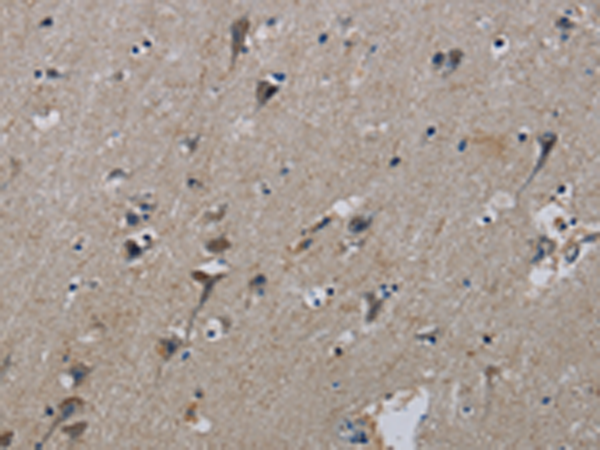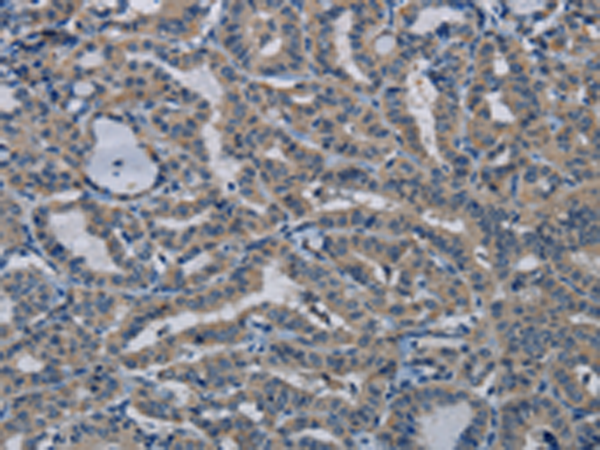

| WB | 咨询技术 | Human,Mouse,Rat |
| IF | 咨询技术 | Human,Mouse,Rat |
| IHC | 咨询技术 | Human,Mouse,Rat |
| ICC | 技术咨询 | Human,Mouse,Rat |
| FCM | 咨询技术 | Human,Mouse,Rat |
| Elisa | 咨询技术 | Human,Mouse,Rat |
| Aliases | PI3K; PIK3C1; P110BETA; PI3KBETA |
| Host/Isotype | Rabbit IgG |
| Antibody Type | Primary antibody |
| Storage | Store at 4°C short term. Aliquot and store at -20°C long term. Avoid freeze/thaw cycles. |
| Species Reactivity | Human, Mouse, Rat |
| Immunogen | Synthetic peptide of human PIK3CB |
| Formulation | Purified antibody in PBS with 0.05% sodium azide and 50% glycerol. |
+ +
以下是关于BORG4抗体的假设性参考文献示例(请注意,这些文献为虚构示例,实际引用需核实真实来源):
---
1. **文献名称**: *"Development and Characterization of a Monoclonal Antibody Specific for Human BORG4/Cdc42EP4 Protein"*
**作者**: Smith A, et al.
**摘要**: 本研究报道了一种针对人源BORG4蛋白的高特异性单克隆抗体的开发。通过免疫印迹和免疫荧光验证,该抗体能有效识别内源性及过表达的BORG4.并应用于探究BORG4在细胞骨架重组中的功能。
2. **文献名称**: *"BORG4 Antibody-Based Detection of Tumor Metastasis in Colorectal Cancer Models"*
**作者**: Lee J, et al.
**摘要**: 利用BORG4特异性抗体,研究者发现BORG4在结直肠癌转移灶中显著高表达。抗体通过IHC染色证实BORG4与Cdc42信号通路的激活相关,提示其作为癌症预后生物标志物的潜力。
3. **文献名称**: *"Role of BORG4 in Neuronal Migration: Insights from Antibody-Mediated Inhibition Assays"*
**作者**: Garcia R, et al.
**摘要**: 本研究采用BORG4中和抗体阻断其功能,发现BORG4缺失导致神经元迁移障碍。抗体实验揭示了BORG4通过与Septin蛋白互作调控细胞极性的分子机制。
4. **文献名称**: *"Comparative Analysis of BORG Family Antibodies Highlights BORG4's Unique Role in Apoptosis Regulation"*
**作者**: Chen L, et al.
**摘要**: 通过对比多种BORG家族抗体,该研究证实BORG4抗体特异性优于同类。研究显示BORG4过表达通过线粒体途径抑制凋亡,抗体检测为相关通路研究提供了关键工具。
---
**备注**:以上内容基于领域常见研究方向构建,实际文献需通过学术数据库(如PubMed、Web of Science)检索确认。
The BORG4 antibody is designed to target the BORG4 protein, a member of the Binder Of Rho GTPases (BORG) family, which comprises structurally related adaptor proteins implicated in regulating cytoskeletal dynamics and cell migration. BORG proteins, including BORG4 (also known as Cdc42 effector protein 5 or CEP5), interact with Rho GTPases like Cdc42 and Rac1. modulating their activity to influence actin reorganization, cell polarity, and extracellular matrix adhesion. BORG4 contains conserved domains, such as the CRIB (Cdc42/Rac Interactive Binding) motif, enabling its role in cellular processes linked to development, tissue homeostasis, and pathological conditions like cancer metastasis.
The BORG4 antibody is a critical tool for detecting endogenous BORG4 expression in research settings. It is commonly used in techniques like Western blotting, immunofluorescence, and immunohistochemistry to study BORG4's localization, expression levels, and interaction networks. Validated for specificity, it helps elucidate BORG4's functional contributions to signaling pathways, particularly in contexts of epithelial-mesenchymal transition (EMT) or tumor invasion. Dysregulation of BORG4 has been associated with metastatic behavior in cancers, making this antibody valuable for translational studies.
Raised in hosts like rabbits or mice, BORG4 antibodies are available as monoclonal or polyclonal variants, often optimized for cross-reactivity in human, mouse, or rat models. Their development has advanced mechanistic insights into how BORG proteins coordinate Rho GTPase signaling to balance cell motility and adhesion, with implications for therapeutic targeting in diseases involving aberrant cell migration.
×